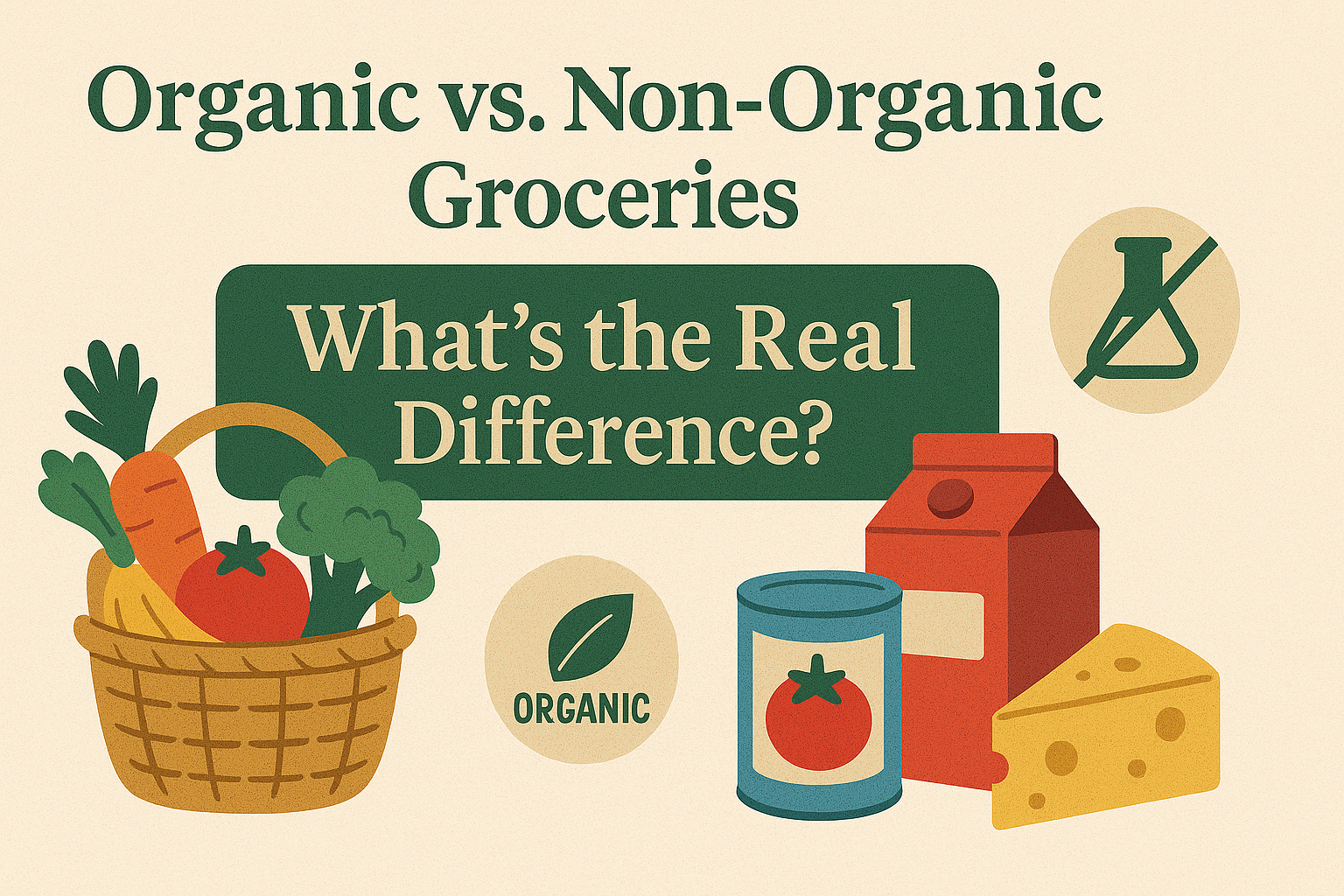With rising awareness around health and sustainability, the debate between organic vs. non-organic food has never been more relevant. From higher prices to cleaner farming methods, organic groceries promise a lot—but are they really better?
In this guide, we break down the real differences between organic and non-organic groceries so you can make an informed shopping decision.
🌿 What Is Organic Food?
Organic food refers to groceries produced without synthetic pesticides, fertilizers, GMOs, or artificial preservatives. Organic farming emphasizes:
- Natural composting & crop rotation
- Animal welfare & antibiotic-free livestock
- Soil health and water conservation
- No genetically modified seeds or growth hormones
🧾 In India, organic certification is regulated by NPOP (National Programme for Organic Production) under APEDA.
🧪 What Is Non-Organic Food?
Non-organic groceries, also called conventional groceries, are produced using synthetic fertilizers, chemical pesticides, and modern industrial methods. They often involve:
- Faster growth cycles
- Use of GMOs and hybrid seeds
- Chemical preservatives to extend shelf life
- Higher yields and cheaper costs
These products are widely available and often more affordable.
📊 Comparison Table: Organic vs Non-Organic
| Feature | Organic | Non-Organic |
|---|---|---|
| Pesticides | ❌ No synthetic pesticides | ✅ Often used |
| Fertilizers | 🟢 Natural compost, green manure | 🟡 Synthetic fertilizers |
| GMO Content | ❌ Prohibited | ✅ Common in crops |
| Antibiotics in Livestock | ❌ Not allowed | ✅ Frequently used |
| Shelf Life | ⏳ Shorter (no preservatives) | 🕒 Longer with chemicals |
| Price | 💸 Higher (20–40% more) | 💰 Lower |
| Nutritional Value | 🥬 Slightly higher in some nutrients | 🍽️ Comparable in many cases |
| Taste/Freshness | ✅ Fresher and more flavorful (subjective) | ⚖️ More standardized taste |
| Environmental Impact | 🌎 Lower (eco-friendly farming) | 🌫️ Higher (chemical runoff, soil damage) |
| Certifications | ✅ India Organic, Jaivik Bharat | ❌ Usually uncertified |
✅ Benefits of Organic Groceries
- Lower Chemical Exposure – Especially beneficial for children and pregnant women.
- Better for the Environment – Promotes biodiversity, healthy soil, and clean water.
- Animal Welfare – No growth hormones or antibiotics in organic meat/dairy.
- Support Local Farmers – Many Indian organic brands source directly from small-scale farmers.
❌ Limitations of Organic Groceries
- Higher Price Point: Often 20–40% more expensive.
- Availability Issues: Limited stock in non-metro cities.
- Shorter Shelf Life: Requires quick consumption and proper storage.
- Certification Gaps: Not all “natural” or “organic” labels are regulated.
🔗 Read: How to Identify Fake Organic Labels in India
🛒 Where to Buy Organic Groceries in India
- Online Platforms:
- Offline Retailers:
- Dmart (select organic SKUs in-store)
- Nature’s Basket
- 24 Mantra Organic stores
- FabIndia Organic section
🔗 Compare BigBasket, Blinkit & Zepto for Organic Product Delivery
🧠 Expert Tips for First-Time Organic Buyers
- Start Small – Try organic for high-residue produce: spinach, apples, tomatoes.
- Look for Labels – “India Organic”, “Jaivik Bharat”, or USDA Organic.
- Buy Seasonal – Helps reduce cost and improve freshness.
- Bulk Purchase Dry Goods – Organic dals, rice, and flours are more stable and economical.
💬 Common FAQs
❓ Is Organic Really Healthier?
Yes, organic food reduces pesticide exposure and may contain slightly more antioxidants. But overall diet and lifestyle matter more.
❓ Why Is Organic More Expensive?
Organic farming has lower yields, higher labor costs, and no chemical enhancers—leading to a higher price.
❓ Are Organic Foods 100% Chemical-Free?
Not always. They must meet certified low-residue limits, but natural pest control (like neem oil) is permitted.
🔗 Related Internal Blog Posts
- Best Grocery Stores Near Me – 2025 Review
- Top Grocery Franchise Opportunities in India
- Best Delivery Apps for Organic Products in India
- How to Invest in Retail Brands Like Dmart and Reliance
📝 Final Thoughts
If your priority is health, sustainability, and chemical-free produce, going organic—even partially—is a step in the right direction. But it’s okay to mix both organic and non-organic depending on availability, price, and lifestyle.
Organic for what you eat most. Conventional for what you wash and peel. That’s a balanced strategy many urban Indians are adopting in 2025.
Are you planning to go grocery shopping and write on paper? why don’t you try Trupricer.com a digital shopping list creator Using trupricer mobile app, you can create a digital monthly shopping list in the app and there is no need to struggle with writing a list on paper every time
Andriod store link to download the app: https://play.google.com/store/apps/details?id=com.trupricer.user
IOS app store link :https://apps.apple.com/in/app/tru-pricer/id6480042106

